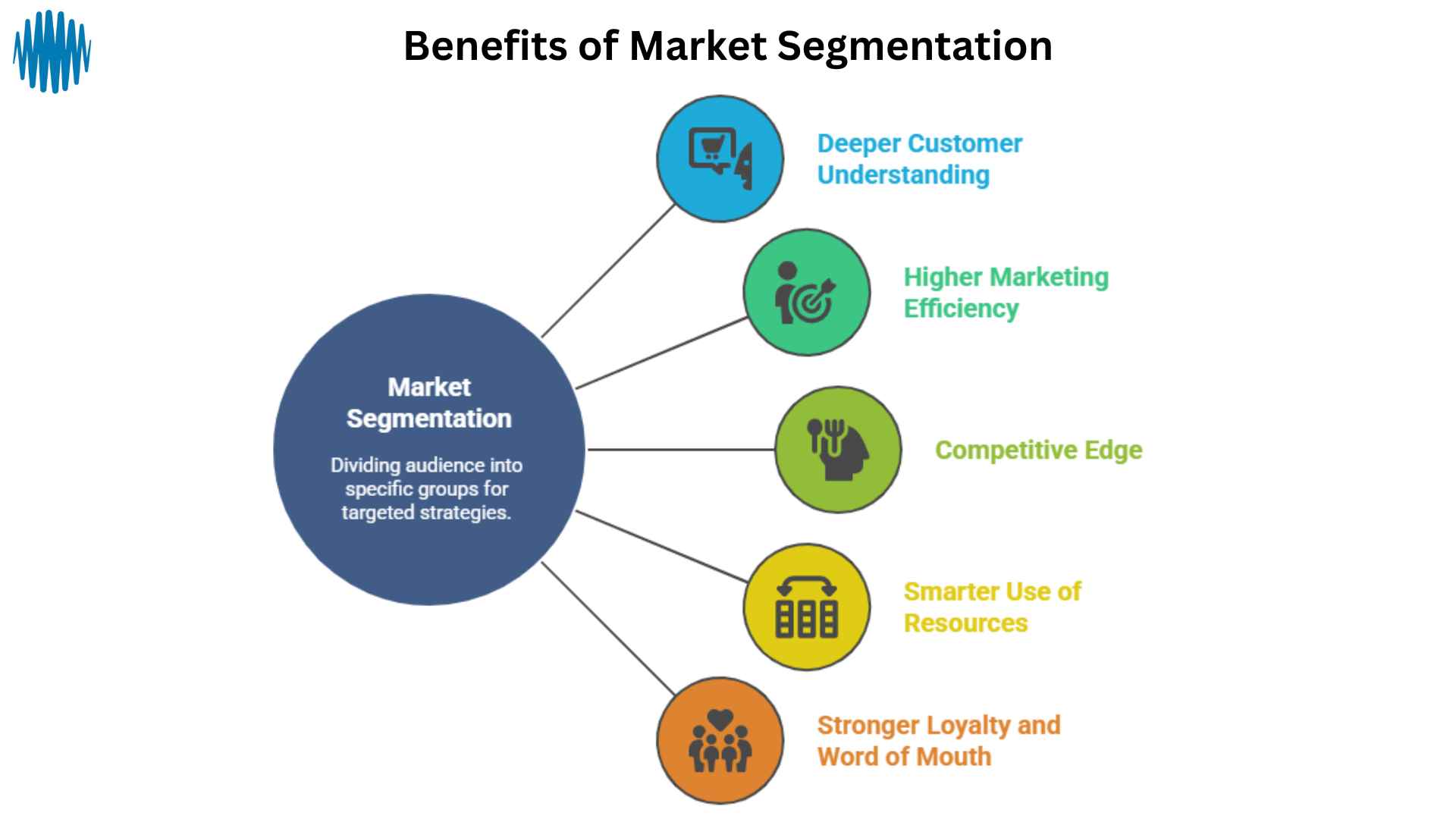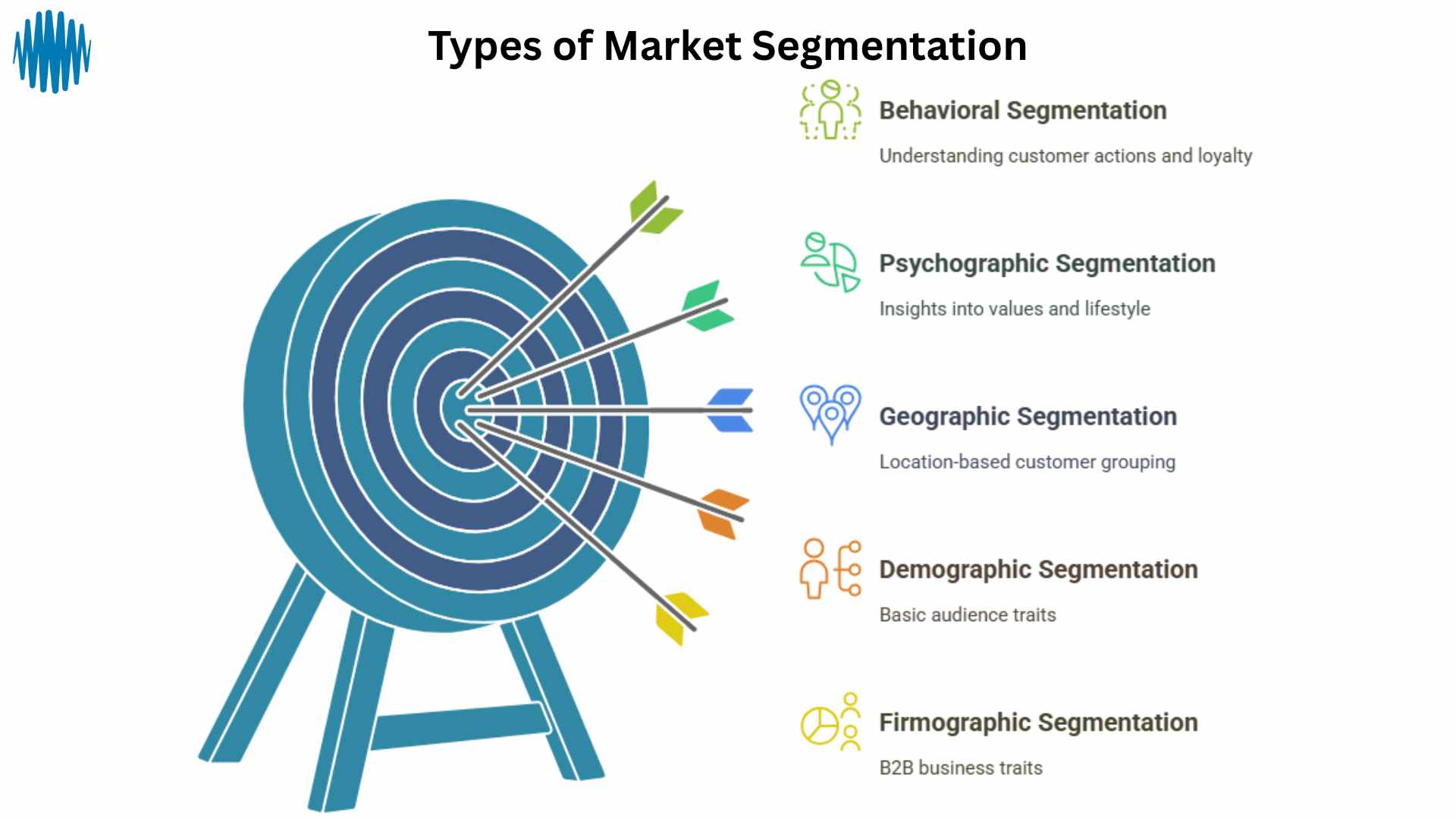Picture this: you’ve spent hours crafting a social media post, maybe even put some of your hard-earned money behind it. And then… nothing. Just a couple of likes from friends and maybe one vague enquiry. It’s frustrating, especially when you know your product or service is great. But often, the problem isn’t the platform or your budget. It’s a lack of market segmentation.
As a small business owner, you try to speak to everyone because turning away potential customers feels risky. Ironically, you end up turning them off instead.
This is where market segmentation comes into play.
Market segmentation helps you focus on the people who actually want what you’re offering. You can speak their language, address their needs, and create marketing that works — without wasting time or money.
In this guide, we’ll explain what market segmentation is, why it matters for small and medium businesses, and how it helps you understand who your ideal customer really is.
Prefer listening? We’ve also covered this topic in our Bots & Brains podcast. Scroll down to the end of this guide to listen right here on the page.
What Is Market Segmentation?
Market segmentation is the practice of dividing a broad target market into smaller sub‑groups of people or businesses that have something meaningful in common.
Market segmentation helps you answer one of the most important marketing questions: “Who is my ideal customer?”
Buyers differ in their wants, budgets, locations, attitudes and purchasing habits. By slicing a large, mixed market into smaller groups, businesses can tailor their products, services, and marketing messages to meet the specific needs and preferences of each group. This targeted approach can lead to increased customer satisfaction and loyalty.
Market segmentation is also the first step in the classic STP framework (Segmentation, Targeting, and Positioning).
- Segmentation is where you identify groups with shared characteristics.
- Targeting is about choosing which groups to focus on.
- Positioning is how you shape your message, so it resonates with the people you’ve chosen.
Understanding segmentation lays the groundwork for everything that follows. Without it, targeting and positioning become guesswork. With it, your communications feel more personal, your offers become sharper, and every pound of ad spend works harder.
Want to learn how to apply all three steps in practice? See our STP marketing strategy guide for small businesses.
Why Is Market Segmentation Important?
Running a small business is a constant balancing act of time, money, and energy. Market segmentation lets you direct those limited resources where they’ll earn the biggest return. Here’s why it matters:

Deeper customer understanding
Dividing your audience into smaller groups reveals the motivations behind each purchase. First-time dog owners, for example, look for guidance and starter bundles, while professional breeders prioritise bulk discounts and specialist advice. Knowing the difference helps you speak their language and solve their specific problems.
Higher marketing efficiency
A Facebook advert aimed at “everyone in the UK” will burn cash fast. Narrow the same campaign to “women aged 30–45 in Bristol who follow eco-friendly brands” and your click-through rate jumps while the cost per sale falls. In short, segmentation turns a scattergun promotion into a laser-focused campaign.
Competitive edge
Large competitors can outspend you, but they struggle to out-focus you. By serving a niche, say, gluten-free desserts for coeliacs, you become the obvious, trusted choice for that group. Customers remember a specialist long after they forget a generalist.
Smarter use of resources
Stock, staff hours, and ad budget flow to the segments most likely to buy. An online stationery shop might discover that teachers place regular mid-term top-up orders, whereas casual shoppers buy only at Christmas. It keeps popular teacher items in stock year-round and plans promotions around school calendars, avoiding dead stock and wasted effort.
Stronger loyalty and word of mouth
When people feel a brand truly “gets” them, they stick around and tell their friends. A running shoe retailer that invites different pace groups to free weekend runs turns customers into a community. And communities are far harder for competitors to pull away.
These benefits all add up to one thing: better results from every pound and every minute you invest in your business.
Different Types of Market Segmentation
Market segmentation isn’t one-size-fits-all. There are a few different ways to group your audience, depending on what matters most to your business. You can use just one method or combine a few for a fuller picture. The key is to choose factors that actually affect how people buy from you.
Here are the five most common types of market segmentation with tips for both new and established businesses.

Demographic Segmentation
Demographic segmentation is one of the simplest and most popular ways to divide your audience. It helps you understand who your customers are, based on traits like age, gender, income, education level, job type, marital status, or family size. These details often shape what people need and how they make buying decisions.
Why it matters:
Demographics give you a practical starting point for tailoring your offer. Knowing someone’s income range can guide your pricing strategy. Understanding family size or age can help shape product bundles, messaging tone, or even when you send marketing emails. This kind of info helps you stop guessing and shows you what might work for different groups of people.
Example:
A local gym runs weekday classes designed for retired residents aged 60+, offering gentle workouts followed by tea and a chat. They promote these sessions through local newsletters and senior-focused Facebook groups.
How to collect the data:
If you’re already running a business, check your existing records such as order forms, email lists, booking systems, or customer accounts. Even basic fields like age range, job title, or household size can give you a useful start.
You can also add short questions to your email sign-up forms, online checkout, or enquiry forms (e.g. “Are you buying for yourself or your family?”). Tools like Google Forms, Typeform, or Mailchimp make it easy to collect this info.
If you’re just starting out, look for trends in your industry. Explore UK Census data or Office for National Statistics reports to understand who typically buys your type of product or service. You can also run free surveys in local Facebook groups or forums related to your niche.
Watch out:
Demographics tell you who your customers are, not why they buy. Two people with the same job and income might want very different things. For better results, combine demographic segmentation with insights from behaviours or personal values.
Geographic Segmentation

Geographic segmentation groups people based on where they live, work, or spend time. You might divide your audience by country, city, postcode, or even how close they are to your shop or delivery area. This type of segmentation is useful when location affects how people buy from you.
Why it matters:
Where someone lives often shapes what they need and how quickly they can get it. If you only serve certain postcodes, there’s no point advertising to people outside your area. Geographic segmentation helps you focus your efforts where your offer makes sense. It’s especially useful for small businesses with physical locations, delivery zones, or area-based pricing.
Example:
A small café chain with three London branches runs separate promotions for each postcode area. Locals near the Camden branch get ads for live music nights, while those near the City branch see breakfast bundle offers for commuters.
How to collect the data:
If you’re already trading, check your customer orders, delivery addresses, or use website tools like Google Analytics to see which areas your traffic is coming from. Even simple info like cities, counties, or postcode regions can help. Platforms like Shopify, Squarespace, or Etsy often give you this data automatically.
If you’re just starting out, think about where your ideal customer is likely to be. Use Google Trends to check which areas show interest in your product type. You can also run a small location-based ad on Facebook or Instagram to test interest in a specific town or region. Another easy option: ask people to share their postcode in a short survey or social media poll.
Watch out:
Location doesn’t tell you everything. Two customers in the same neighbourhood might have very different lifestyles or budgets. Use geographic segmentation alongside other types to avoid making assumptions.
Psychographic Segmentation
Psychographic segmentation focuses on why people make buying decisions based on values, interests, attitudes, lifestyle choices, or personality traits. It goes deeper than age or location and helps you understand what matters most to your customers. This is especially useful when your product or service speaks to personal identity, beliefs, or habits.
Why it matters:
When people feel like a brand “gets” them, they’re more likely to buy from it and stick with it. Whether it’s sustainability, creativity, family focus, or a love of simplicity, tapping into those values helps you build stronger, more lasting connections. Psychographic segmentation is what makes a message feel personal, even when you’re speaking to hundreds of people.
Example:
A small meal prep business segments its audience by lifestyle values. One group is health-focused professionals looking for clean ingredients and portion control. Another group is busy families wanting time-saving recipes. Instead of running one campaign for everyone, they tailor two different sets of ads, menus, and email subject lines to match each group’s mindset.
How to collect the data:
If you already have customers, start by reading what they’ve said in reviews, testimonials, emails, or social media comments. What words keep showing up? Are they talking about saving time, supporting small businesses, avoiding waste, or feeling inspired?
Ask direct questions in polls or surveys:
- “What matters most to you when choosing [your product type]?”
- “Which of these describes you best?” (Then give 3–5 value-based options.)
If you’re starting from scratch, join relevant Facebook groups or forums in your niche. Watch what people say, what questions they ask, and what they complain about. You can also run a short survey using Google Forms or SurveyMonkey and offer a discount code or freebie as a thank-you.
Watch out:
Psychographic data is more subjective than other types. People don’t always say what they truly think or act the way they describe. Try to match what they say with what they do, and look for consistent patterns, not one-off comments.
Behavioural Segmentation

Behavioural segmentation groups people based on what they actually do – how they shop, how often they buy, when they engage, and how loyal they are. This type of segmentation helps you understand patterns in real actions, not just opinions or demographics. It’s especially useful for improving customer retention, building loyalty, and sending the right message at the right time.
Why it matters:
Past behaviour is one of the best ways to predict future action. Someone who buys from you every month behaves very differently from someone who browses once and leaves. When you know how people interact with your business, you can send better emails, create smarter offers, and spend less time chasing the wrong customers. It also helps you spot your best customers, so you can treat them like VIPs.
Example:
A skincare brand notices that one group of customers always buys refills within 6 weeks, while another only buys during sales. They create a subscription option for the first group and send early access discounts to the second.
How to collect the data:
If you’re already trading, check your order history, payment logs, or online store dashboard to see who’s buying most often and when. Platforms like Shopify, Etsy, and Squarespace usually show customer behaviour reports by default.
You can also look at email engagement (who opens, clicks, or ignores) and website analytics (who comes back, who abandons their cart). Even a simple spreadsheet of order dates can reveal useful buying patterns.
If you’re just starting, use your competitors as a learning tool. Look at their reviews, product pages, or social media posts. What do people love, what do they buy often, and when do they buy it? You can also test small changes yourself. Offer two different versions of a product or run a limited-time promo, and see which gets more responses. That’s behavioural data too.
Watch out:
Customer behaviour isn’t fixed. It can shift with the seasons, the economy, or your own offers. Review your behavioural data regularly to avoid basing decisions on patterns that no longer apply.
Firmographic Segmentation (for B2B)

Firmographic segmentation is like demographic segmentation, but instead of grouping people, it’s used to group businesses. It helps you organise your potential B2B customers based on shared traits such as industry, company size, revenue, location, or how established they are. This is especially useful if you sell to other businesses and want to tailor your offer to different business types.
Why it matters:
Not all businesses need the same thing. A five-person startup and a large corporation have different budgets, priorities, and decision-making processes. Firmographic segmentation helps you create more relevant services, pricing, and messaging, so you don’t waste time pitching the wrong offer to the wrong business.
Example:
A cybersecurity company tailors its content by business type. It sends compliance checklists to healthcare clients who deal with sensitive data, while fintech firms receive case studies showing return on investment and cost-saving tools.
How to collect the data:
If you already have business clients, start with what you know, such as industry, company size, services used, and how long they’ve been trading. You can gather more during onboarding by asking simple questions on your forms like “What’s your business type?” or “Roughly how many employees do you have?”
If you’re still trying to attract B2B clients, research businesses in your niche using free tools like:
- Companies House
- LinkedIn company search
- Business directories like Yell, Clutch, or industry-specific listings
Look for patterns: Are there sectors that seem underserved? Are small firms complaining about costs while large firms want scalable solutions?
And don’t underestimate the value of real conversations. A few direct chats on LinkedIn, at local meetups, or in online groups can give you honest insights about what different businesses need.
Watch out:
Firmographic data (like company size or industry) doesn’t tell the full story. A small company might make decisions quickly, or it might need approval from five people. Whenever you can, combine firmographics with behavioural insights – like what content they download, how they interact with your emails, or what questions they ask.
Final Thoughts about Market Segmentation
Trying to speak to everyone often means connecting with no one. It’s a common trap, especially for small businesses wanting to grow. But when your message tries to appeal to everyone, it rarely lands with the right people.
That’s where market segmentation comes in. It’s simply about understanding who your customers are, what they care about, and how to speak directly to them. When you do this well, your marketing becomes more focused, more effective, and more human.
Ready to start? Check out our Customer Segmentation Table – a free practical tool to help you organise your audience, compare different segments, and decide where to focus first.
And if you’d like help turning this insight into action, Social Matrix is here for you. Contact us today to shape a strategy that truly fits your business.
If you’d rather listen than read, we’ve turned this guide into an episode of our Bots & Brains podcast. In it, we walk through everything we’ve covered here, with real-life examples and practical tips to help you apply segmentation to your business.
Hit play below to listen without leaving this page, or bookmark it for later when you’re on the go.
Market Segmentation FAQs
What is the primary goal of market segmentation?
The primary goal of market segmentation is to group potential customers with similar needs and characteristics so you can tailor offers and messages that feel personal, boosting relevance and ROI.
What is the first step in market segmentation?
The first step in market segmentation is to map the different kinds of customers you already serve, or expect to serve, using basic data like sales records, quick interviews or competitor reviews.
Is market segmentation only for big companies?
Market segmentation is not only for big companies; small businesses often gain even more because segmentation lets them focus limited budgets on the customers most likely to buy.
How does segmentation affect pricing?
Segmentation affects pricing by revealing each group’s willingness to pay, so you can create budget bundles for price-sensitive shoppers and premium tiers for high-value buyers.
What tools can help with segmentation?
Tools that can help with segmentation include free options such as Google Forms for surveys, Google Analytics for web data and Meta Business Suite for social insights, plus paid solutions like CRMs or LinkedIn Sales Navigator for B2B firmographics.
What are the 4 types of market segmentation?
The four main types of market segmentation are demographic, geographic, psychographic and behavioural. There is also a fifth type used mainly in B2B marketing – firmographic segmentation, which classifies companies by traits such as industry, size or revenue.
What are the advantages and disadvantages of market segmentation?
The advantages of market segmentation include sharper messaging, better ROI and stronger loyalty, while the disadvantages include extra research time, the risk of missing new markets and the need for regular updates.
What is the main requirement for effective segmentation?
The main requirement for effective segmentation is that each segment must be measurable, accessible and large enough to be profitable, often described by the MAD test (Measurable, Accessible, Durable).
Why is market segmentation useful for targeting and positioning?
Market segmentation is useful for targeting and positioning because, once you know who wants what, you can choose the best segment to pursue and craft an offer that fits their expectations.
How to choose a market segment?
To choose a market segment, score potential groups on size, profit potential, ease of reach, competitive intensity and fit with your strategy, then pick the one with the best overall score.
What is a wandering customer?
A wandering customer is someone who browses without a clear intention to buy. In market segmentation, this behaviour can help define a low-intent segment that needs more nurturing, such as guidance, reassurance, or educational content, before making a decision.
What are the limitations of market segmentation?
The limitations of market segmentation include that segments can become outdated as markets shift, may overlook emerging niches, and require ongoing data collection that some small firms find time-consuming.

